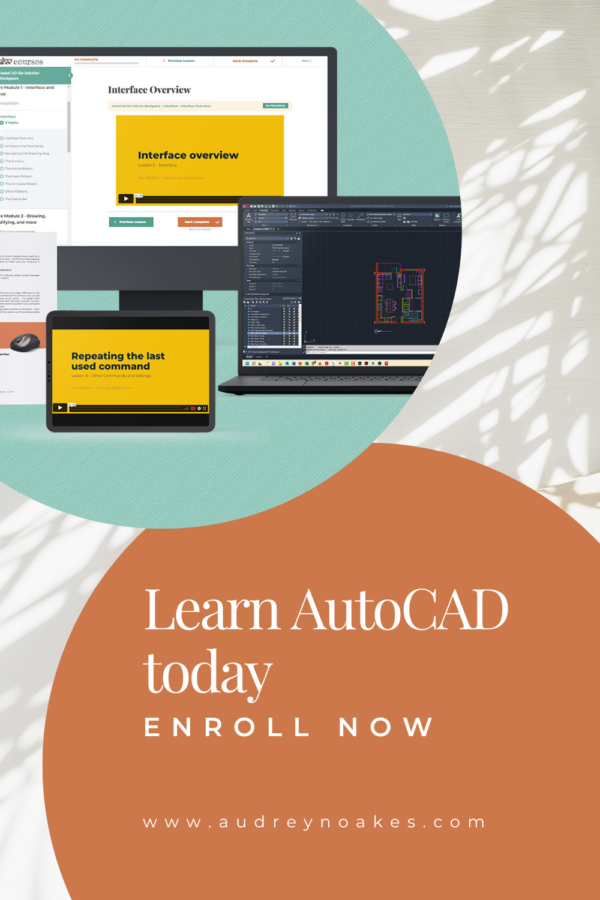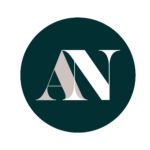Affiliate Disclaimer
Some of these links on this page are affiliate links, meaning I earn an affiliate commission if you decide to purchase (*indicates affiliate links). However, I recommend these tools no matter what.
There’s been a bit of buzz about shoppable pins, posts, and pictures lately. Houzz made a lot of enemies not too long ago, and it looks like Pinterest in now making them too. I love Pinterest. Most of you probably found this website via Pinterest. Also, I automatically go to Pinterest for ideas and inspiration. But I certainly see where some designers are coming from in how the latest feature of shoppable pins. For residential designers especially, this is problematic. Where much of a project’s profit is tied to furniture sales, it can be pretty damn frustrating to make it easy for someone to replicate your work with just a few clicks on Pinterest. I also definitely find the ethics of copyright and earnings a bit suspect as well, and I think it would benefit from further clarity.
But I do think there’s another side to this issue. If a shoppable pin can take away our livelihood, it honestly feels like we’re not valuing our own skills and expertise enough. If that’s true, our industry has a much bigger issue than shoppable pins.
So in this post we’re going to look at the issue from two sides.
- What are the actual technical fixes we can do to prevent shoppable pins or the theft of our images
- What mindset shifts need to take place to make shoppable pins an advantage instead of a disadvantage
Technical Fixes for Preventing Image Theft
First, let’s dive in on some technical fixes regarding this whole shoppable pins / image theft issue.
Firstly, you can make images on your website ‘non-pinnable’. This means they won’t be an option if someone is trying to pin or save the picture from your site to one of their boards. This can do 3 things for you:
- This means you can protect some images of your work to only be viewable directly on your website, shown exactly how you want it to be shown.
- This means the images that are pinnable can be intentionally branded and designed in a way to encourage people to click through or learn more about its creator.
How to make a single image non-pinnable on your website
This is a quick fix, but it does require a bit of know-how on the back end of your website. Essentially, you need to add the code:
data-pin-nopin="true"
Let’s look at how I can do this for the image below (taken from Unsplash.com). The first version of this image looks like this and appears like this in the text editor of my blog post – I use WordPress for my site.
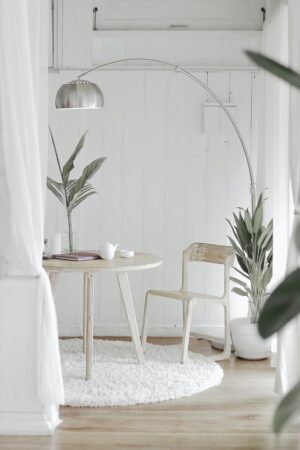

The second version of this image looks like this, but appears like this in the text editor of my blog post. It’s a very minor difference, but only one of these images is pinnable.


I have the Pinterest Chrome Extension on. So if right-click on this image, I can see Pinterest giving me a Pin it option, but when I go to click it, I get a warning saying, NOPE! I can’t pin it.

So just like that I’ve prevented this image to be pinned on Pinterest from my site. This means I can go through my blog posts or website pages and add just a little bit of code to make sure the images I want to protect are protected.
How to make all images non-pinnable on your webiste
Now, because I think Pinterest, can still be really valuable to designers, I don’t recommend this next approach, but if you’re really worried about the theft of your images, you can actually make all images on your website non-pinnable. Again, this requires a bit of know-how on the back end of your website. Essentially, you need to add the code:
<meta name="pinterest" content="nopin" description="Sorry about that! We don't allow pins from this website" />
This code will need to go in the header of the site. I use a plug-in to make it easy for me to add things to this part of my website, without having to go too far into the back end to make these edits. But with this simple bit of code, you’ve made it impossible for any image to be pinned from your website. You can change the description in quotations to say whatever you want, but essentially, this code will give an error message to anyone trying to pin from your site.

How to prevent an image on your website from being saved
Now I know, some people have asked, well, what’s from stopping someone from just saving the images from my site and pinning them themselves. Again, there’s some code you can add to make it where that right-click > Same Image As options is not available on your images.
In this case you’ll want to add this bit of code to your images in the text editor of the post or page:
oncontextmenu='alert("Image context menu is disabled");return false;'So let’s see what this code looks like in the text editor.

This is the message received when someone right-clicks.

You might notice though that these images are still pinnable. So in this case, you’d need to add both snippets of code to make the image both unsavable and non-pinnable.
How to EXTRA protect your images
How to prevent images on your website from being screenshot or saved
Now we’re really getting into the ability to control what happens to our images. WordPress plugins like ‘No Right Click Images’ can give you some further security by preventing any user from screenshotting or saving your issues.
I’m afraid this section is really above my pay grade, but there are further ways to prevent your images from being saved, stolen, etc.
If you’re savvy and have the time, you can upload your image in pieces. Essentially, with this method, if someone was to go and download the image, even all the pieces, they’ve just been given a puzzle that has to be reassembled in order for it to be a usable image.
If you’re savvy on the web side of things, you can also simply place a transparent file of the same size directly on top of your image. This means if someone were to right-click and try to save it, they would only be saving a blank image. Here’s some great instructions on how to do that.
Make Pins Specifically
So in my opinion, some of these methods are just overkill. At a certain point, it might be more trouble than it’s worth. You can certainly go about making some images non-pinnable from your site. However, what goes hand-in-hand from that is making sure the images you do allow to be pinned are valuable, branded, and highly clickable. Images without these kinds of details are simply to easy to view as inspirational scrapbook type images. They’ll get pinned to a board and stay there forever because the pinner doesn’t really need to find out any more information.
But if the pin is designed and showing value it becomes so much more clickable. This takes people to your site, where your hard work, creativity, and expertise can be visible on your own terms. It can help you separate the timewasters or copycats from the people who are seriously interested in your work or your expertise.
So what can you do to these images. Here, I’ll make some generic examples with an Unsplash image.
1. Add your branding. Twice if possible. Don’t let an image just float away without your name attached to it. There are creative ways to add your logo and your URL where the creator and source of the image will be known.
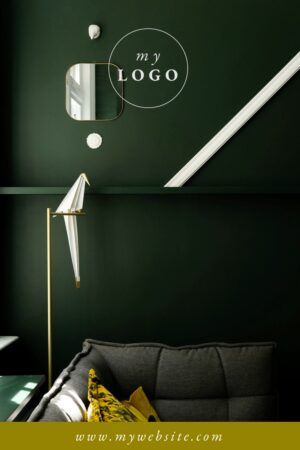
2. Add good titles that pique someone’s curiosity, as well as obscure the images in detail. This will first make someone want to click through to understand what you’re talking about. But this will also make it just a bit harder for the technology to identify the content of the image accurately and effectively.
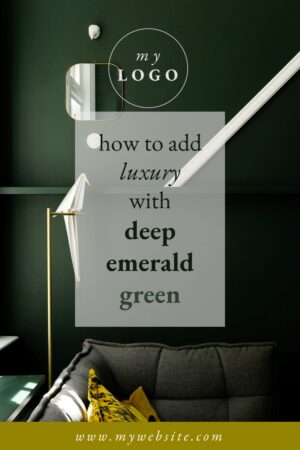
3. Give them something to click on. It can seem a bit silly, but innate in us seems to be the desire to click buttons or do what we’re told. Arrows, click here, and button graphics are a great technique to make your image not just saved for inspiration but saved as a resource to explore further.
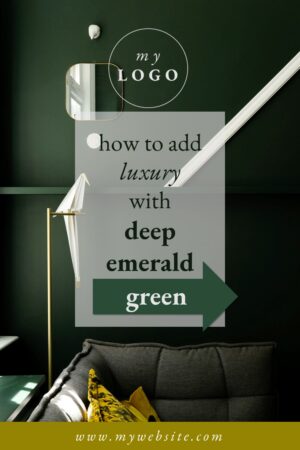
Canva*, Photoshop*, or even PowerPoint/Keynote can make this really easy, but it does take a little bit of extra work. However, the 5 minutes taken to create the image like this just might bring your next client to your site, so it might actually be worth it.
The Interior Designer Mindset
So that wraps up the technical fixes, but now, I’d like to dive in a bit deeper on this issue.
I don’t think shoppable pins will kill the interior designer as a profession. If a shoppable pin that shows a consumer where they can find similar products to create a look erases the need for the designer, I don’t think that’s my definition of an interior designer. That mentality reduces an interior designer to just a professional shopper which is so far from the truth that the fear of shoppable pins actually just makes me sad. It means there are designers out there who aren’t putting the appropriate value on what they do. So I have a few points that I think need to be addressed regarding the underlying insecurity and mindset that’s causing some of these issues.
You are not a professional shopper. You are an interior designer.
Someone will always be able to find a similar sofa, dining chair, wallpaper, etc. It’s a global economy, and the world is online. It’s frankly already easy to ‘shop’ for a particular look, shoppable pins and images just make it a little bit easier. That’s ok, because at this point in technology, there’s a whole lot of thought and consideration that’s missing from that suggestion of a product. Beyond the idea of a style, there are or at least should be a number of factors that went into creating that design:
- Space Planning
- Product Quality
- Practicality for the specific use
- Budget
- Client or Brand’s personality/ethos/background/preference
- Larger conceptual ideas
- Etc.
If someone were to take the first suggested product for an entire space and attempt to recreate it on their own, I imagine the choices would give them quite a bit of trouble. They might not fit in the space or in the budget. They might clash with the rest of the property or be just an impending disaster for cat hair collection. There are a whole host of factors that will need to be addressed before that choice will be the for-certain right choice for someone individual project.
Timewasters and copycats will always exist.
This just comes with the territory to a certain extent. If someone sees your creative work, falls in love with it, and wants it for themselves, there will always be people who go about creating it for themselves. These are the people who don’t hire designers. They’ll always have a hard time looking at the creative result and understanding the time, expertise, and craft that went into creating that result. These are the people, you’ll never convince of your value as a professional, so don’t bother worrying about them.
Even if shoppable pins didn’t exist, these people wouldn’t be clicking through to your site and hiring you for your services. They might ask some questions, but ultimately, they’ll want to do it themselves. Sometimes it’s a valid adaptation of your own ideas, and sometimes its a straight like-for-like copy. In most cases it’s worth just letting it go with the confidence that your hard-won design will always be the better result.
Go beyond the look.
Let’s think about how we talk about design. Too many people think design is about the look. Colors and style. But there’s a whole lot more to it than that as any interior designer knows. It’s actually one of my favorite things to see happen in my students. There is a moment of realization about the complexity about being an interior designer. Then later there is a moment of realization about the confidence they have about being able to handle that complexity as an interior designer. It’s a wonderful thing to see in students, but I definitely notice that confidence falter in some professionals. So if these shoppable pins make you nervous, I definitely want to ask you to take a good look at yourself, your skills, your expertise, and your creativity. It’s so much more than a ‘look’ going into a good design, and there’s a whole lot more than a ‘look’ coming out of a good design. Remember that.
Let’s be open minded.
Finally, let’s be open minded. I’m always pushing to learn or try new things. (Except for TV as I’m watching Season 6 of The Golden Girls for the 3rd time… this year). Technology has always implemented changes in the design profession. Technology has changed how we develop, present, and market our designs and services. So while the disadvantages of the latest technology can be distracting, I prefer to look at the opportunities it can afford as well. In the case of these shoppable pins, I see this as an opportunity to be more intentional and effective with the images we choose to share.
Key Takeaways
- Choose which images you want to share and add
- Edit the images you share to optimize their effectiveness
- Value your work as a professional
Hope that gives you some quick fixes as well as things to think about as the world of shoppable images continues to expand. If you like posts like this, be sure to subscribe!
harness the power of your Pinterest profile with Tailwind
I’m still a big fan of Pinterest not only as a research tool but also as a marketing tool. Pinterest is how most of my readers even find this site. Make managing Pinterest as a marketing tool oh-so-easy by using Tailwind. Tailwind makes it so easy to follow Pinterest best practices and schedule pins easily. It’s also super affordable.
This is an affiliate link, meaning I earn an affiliate commission if you decide to subscribe. However, I recommend Tailwind no matter what. 🙂

